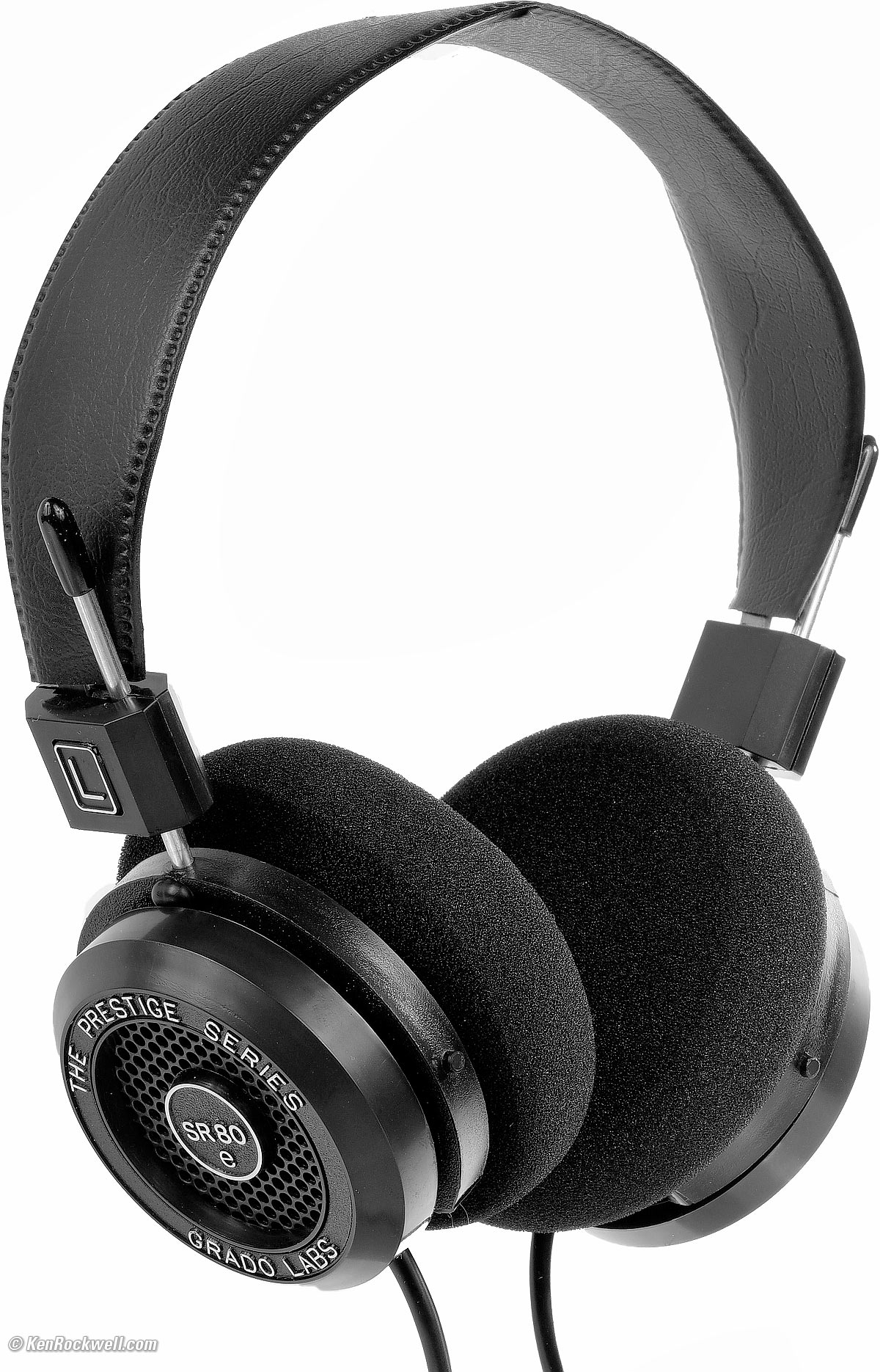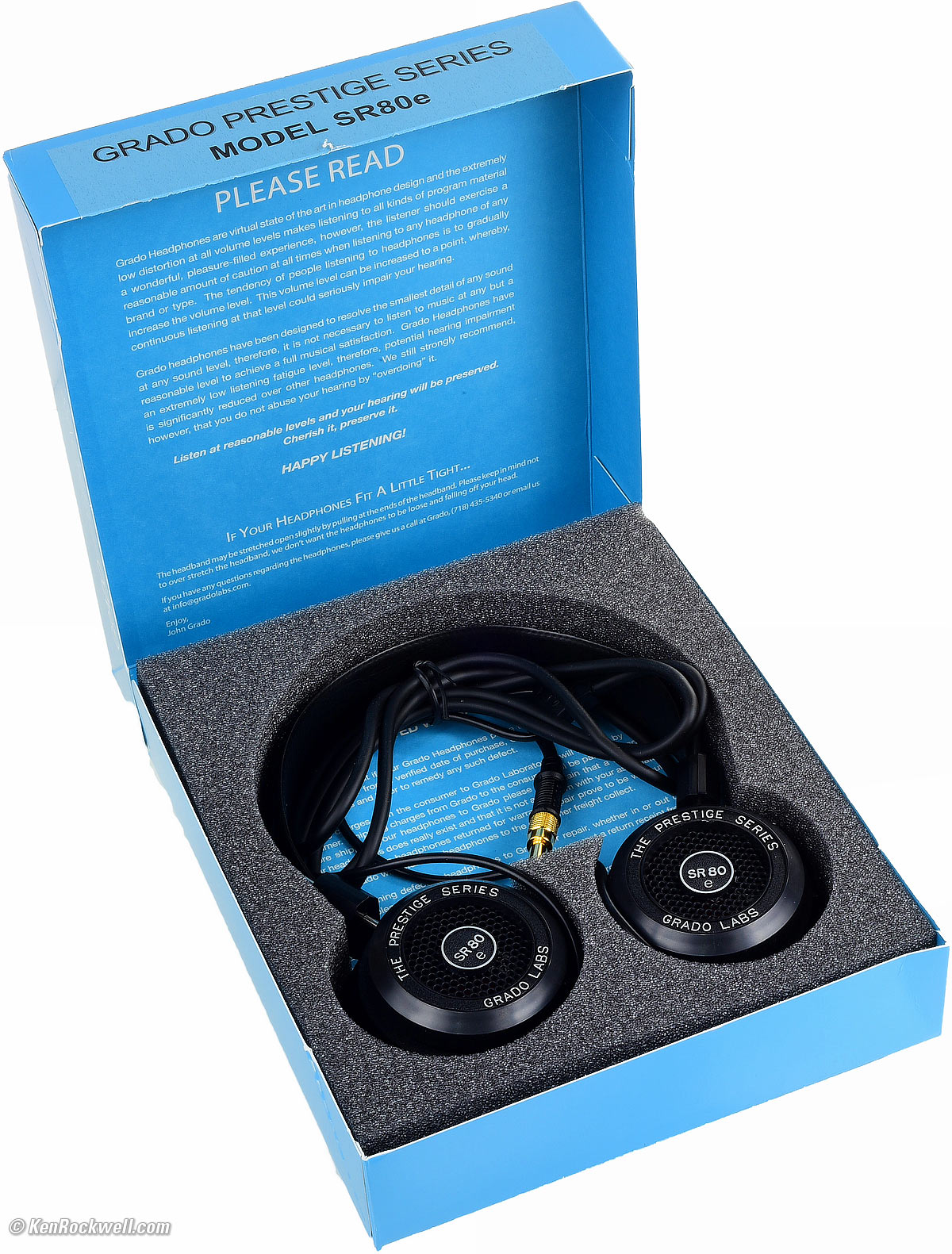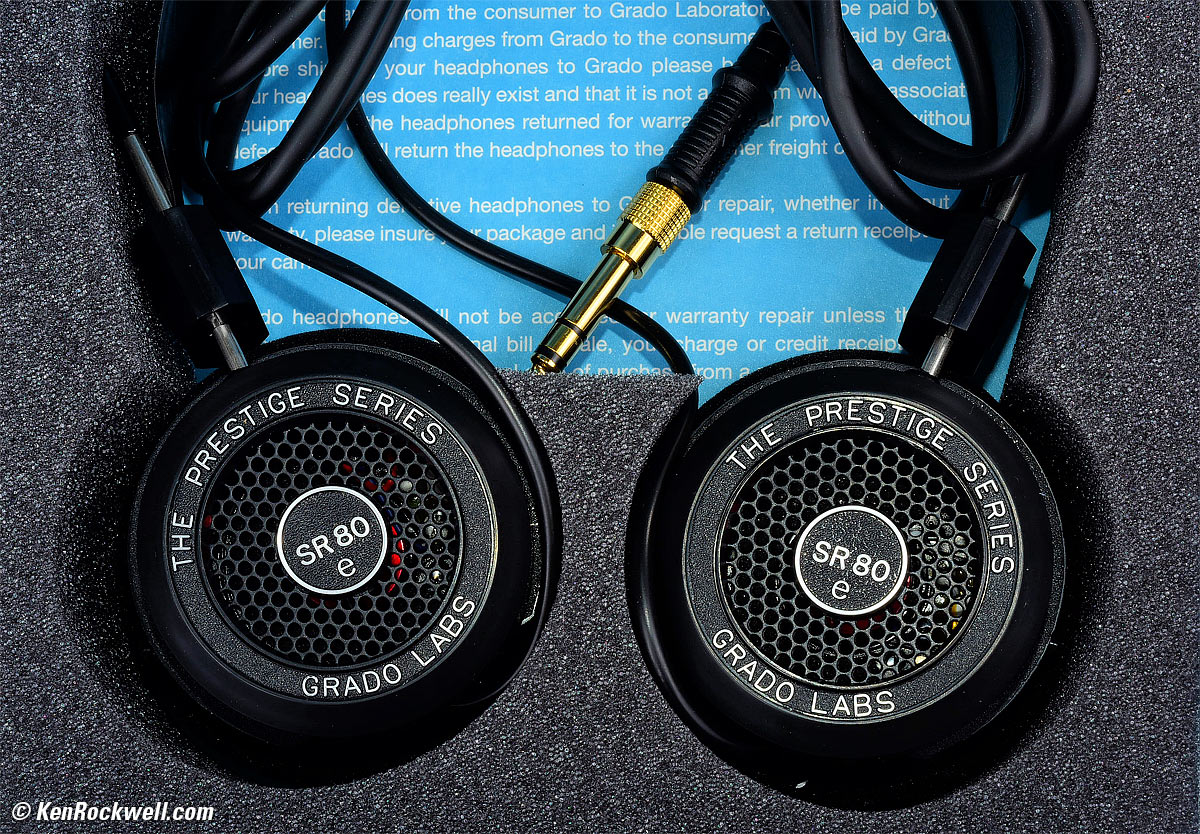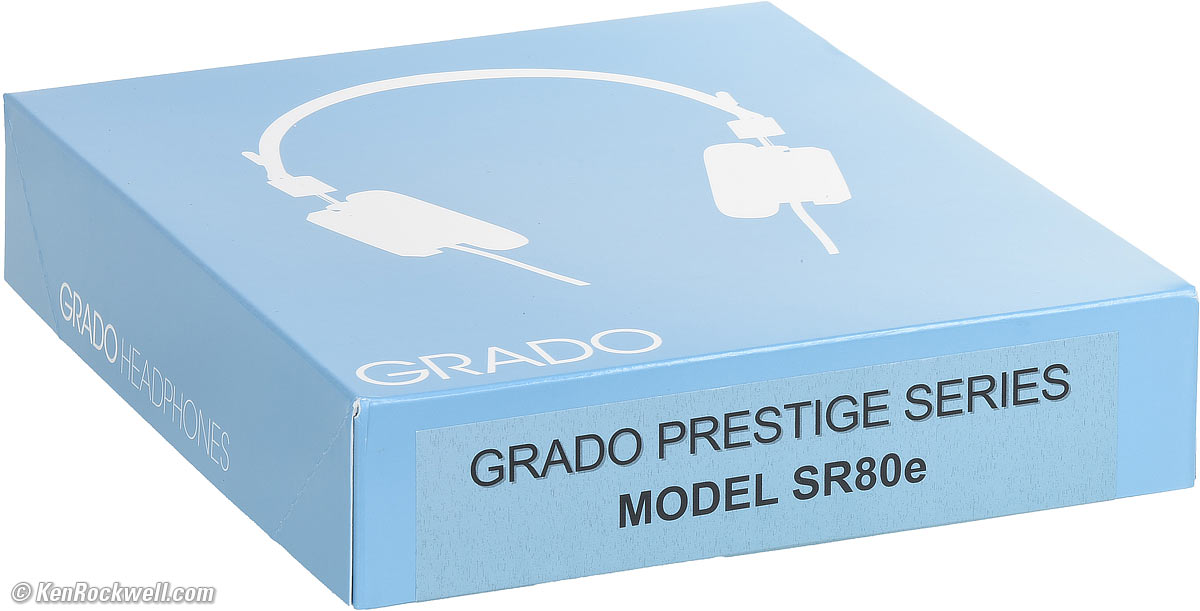Grado SR80e
World's Most Accurate $99 Headphone
Made in USA
Intro Specifications Performance
Compared Usage Recommendations
Grado SR80e (32Ω, 8.3 oz./235 g without cord, about $99) bigger. I'd get mine at Amazon, at B&H or at Crutchfield.
This all-content, junk-free website's biggest source of support is when you use those or any of these links to my personally-approved sources when you get anything, regardless of the country in which you live. Buy only from the approved sources I use myself for the best prices, service, return policies and selection. Thanks for helping me help you! Ken.
July 2017 Grado reviews audio headphones tube amps all reviews
Introduction
Top Intro Specifications Performance
Compared Usage Recommendations
|
I buy only from these approved sources. I can't vouch for ads below. |
The Grado SR80e have been among the world's most highly rated and best selling headphones for years because they are the most accurate headphones you can get for under $200 — not bad since they sell for $99. Now you know why they are so popular!
While other headphones at the same price may have boosted bass and colored midrange that may impress the innocent, there are no headphones at this low price that are as musically accurate. The SR80e reproduce sound as it was recorded, with nothing added and nothing taken away.
The SR80e are quite an ear-opener: they sound natural, without any of the harsh, colored midrange that plagues every other headphone in this price range. The SR80e have silky-smooth natural sound without any of the glare you get in other headphones at this price.
The SR80e are the perfect choice for people who want an open headphone for natural, uncolored sound at the lowest possible price. In light of their low price, they are the perfect headphone for use where a musical institution needs multiple headphones for things like evaluating audition tapes or provided for use by patrons in a music library.
This is a headphone designed for reproducing music accurately for people who care. It has no remote controls and no microphone; this isn't an iPhone headphone to wear while making phone calls.
Who is Grado?
Grado is the real deal. They're a family-owned company founded in Brooklyn, New York in 1953 to make phono cartridges for turntables. They've been making first-class headphones for decades, long before it became the "in" thing.
Grado makes every set of headphones by hand in their building in Brooklyn. The Grado family has been in this building for over 100 years.
The reason casual consumers may not have heard of them is because they're so good that they don't have to advertise. People who know audio and know quality know them, so they'd rather spend their money making better products than trying to advertise to people who probably wouldn't know quality anyway. Do Ferrari, Bugatti or Bentley advertise? Of course not. Do Honda and Toyota have to advertise? You tell me.
I've been familiar with Grado since the 1970s. They've been a player in high-end audio forever, having innovated and patented numerous major advances in phono cartridges.
I always respect any company where the man who owns it puts his name on every product. The Grados are now in their third generation, still making their products by hand in the same building in Brooklyn.
Bravo!
Good
● Smooth, detailed natural sound.
● Smooth, tight, unboosted, non-resonant and non-boomy bass. Every note is distinct.
● Very sensitive; no amplifier needed. Just plug into your phone or iPad and you're done.
● Low price.
● Easy to get replacement foam ear cushions if you need them in twenty years.
● Made in USA 🇺🇸.
Missing
● No bass boost, so can sound thinner at lower levels than other more colored headphones.
● No remote control.
● No microphone.
Specifications
Top Intro Specifications Performance
Compared Usage Recommendations
Type
Open-air, on-ear dynamic headphones.
No remote control or microphone.
Impedance
32 Ω.
Frequency Response
20 ~ 20,000 Hz.
Sensitivity
Rated 99.8 dB SPL at 1 mW.
1 mW at 32 Ω is 179 mV (-14.95 dBV), so 99.8 dB at -14.95 dBV is 114.75 dB SPL at 1 volt input.
Cord
5' cord.
3.5mm stereo plug.
Fat, round soft cable.
Quality
Drivers matched ± 0.1 dB.
Made in USA.
Weight
8.3 oz. (235 g) actual measured weight without cord.
Included
Grado SR80e box. bigger.
Grado SR80e box. bigger.
Headphones.
¼″ adapter.
Price, USA
July 2017: $99.
Grado SR80e box. bigger.
Box size: 2.0 x 8.0 x 9.2 inches (50mm x 234 x 202 millimeters).
Performance
Top Intro Specifications Performance
Compared Usage Recommendations
Overall
These are the most natural sounding headphones you can get for under $200.
They are a typical American product: designed to work great, with all the emphasis on how well it works and little emphasis on packaging. Unlike the Chinese-made rubbish that floods the market with fancy packaging and glitzy-looking headphones that have little to no quality on the inside, these Grados put all the quality inside where it counts, and don't come in a fancy box or use showy parts on the outside. With Grado, who don't advertise either, all the quality is on the inside.
Sound
The SR80e have nothing but smooth and natural sound. I could listen to these forever; there's nothing out of place. Nothing is emphasized and the bass is pure and unboosted.
They have loads of detail. You'll here everything that's part of the music, and everything like chair creeks, breathing and page turns that isn't part of the music but's in the recording anyway.
With no peaks in their response, there's nothing to hide other sounds.
They just sound like the music, never calling attention to any sound of their own. They have lush, full delicious concert sound.
Piano sounds magnificent. The violin section might have about 5% glare, but you'll have to spend five times as much to get anything better.
Good recordings sound the best, and bad recordings will sound bad. What you hear is what you've got.
The SR80e are open, detailed and clean. Every instrument and every note is distinct — especially in the bass, where many other headphones boost it with resonance which emphasizes some notes while hiding others.
The sound doesn't change as moved around your head, they just get softer if they're out of place. This is excellent: it means that they'll sound good for everyone and that you won't have to worry about adjusting them just right.
Bass
Bass is completely natural and unboosted. It simply rolls off below a certain point with no peak or resonance — exactly as it should be. These are not at all boomy.
As a bass player I love boosted bass, but these headphones are unusual in having natural, not boosted bass.
Many people find boosted bass more fun, and if this is you, these aren't the best headphones for you.
Due to our ear's natural lack of bass response at low volume levels, if you want more bass, just play them louder and you'll hear more.
Ergonomics
These have lots of pressure against the ear, which helps take pressure off the unpadded harp.
The earpieces have plenty of freedom to move so they sit perfectly on your ears.
The SR80e stay on your head if you move around because of the pressure against your ears, but try not to move around too much because the plug is big and could get bent of you banged it into anything or yanked the cord sideways.
The sound and the comfort make it easy to enjoy the SR80e for hours and hours. You'll not want to take them off.
Sensitivity
These are 32 Ω headphones with loads of sensitivity when plugged directly into portable devices.
I only run the volume about halfway up enjoying movies on an iPad.
For music I also only run the volume about halfway up, and even for quiet sections of classical music there is plenty of sensitivity when plugged into an iOS device.
As Grado cautions in the box, these sound so smooth and are so sensitive a far bigger problem than not having enough volume is that it's so easy to play them so darn loud for so long that you really can damage your hearing; be careful!
Isolation
These are open headphones and do not muffle outside sound.
You can hear right through them.
Leakage
Like all open headphones, just as much sound comes out the back as comes out the front to your ears.
People sitting next to you will hear your music; these are for use in quiet environments alone, not for use in a quiet office sitting next to people.
Mechanical Quality
Grado puts all your money into sound quality in the SR80e, not into fancy boxes or mechanics.
Therefore the yokes and housings are all plastic, with a metal harp (top strap that connects both sides). The harp's cover is just a piece of thin plastic. Don't sit on these and they'll last a life time.
It has a fixed round plastic cable with a gold-colored 3.5mm plug and gold-colored ¼″ adapter.
Compared
Top Intro Specifications Performance
Compared Usage Recommendations
Here's a secret: as far as I can hear and measure, these use essentially the same drivers as some of Grado's more expensive headphones like the SR325e. The SR325e sound a little brighter and more sensitive because they use open-center foam rings as cushions instead of foam cushions that completely cover the earpieces as on the SR80e.
I swapped the foam rings of the SR325e with the foam covers of the SR80e, and voilà, the SR80e now sounded identical to the SR325e. How identical? I took one driver of each of the two models, used each for left and right on my head but used matching foam cushions on each, and they formed a flawless point-source mono image, or a perfect stereo image.
Therefore, if neutral sound is what you want and you want to save money, the SR80e are your best buy. If you'd like the same great sound but with fancier metal earpieces, top-grain leather headband and nicer touches all around, get the SR325e. There may be other factors that make the sound different between these, but I can't hear any difference other than the different cushions.
Likewise, if you prefer a slightly brighter sound, order the replacement foam cushions for the SR325e and you'll get the same sound out of the SR80e.
Yes, there are many differences between different models of headphones, but for all I can hear and measure, the drivers and the sound is the same.
I didn't audition the less expensive SR60e. They probably sound identical, however I'm told the SR80e precision match and select the left and right drivers, which isn't done in the SR60e. For an extra $20 for a product which ought to last a lifetime, I really like my left and right channels matched to a fraction of a decibel.
For less money the Sony MDR-V6 and similarly priced Sony MDR-7506 headphones have boosted (more) bass, but much rougher midrange. They are closed headphones. The Sonys are designed for quality monitoring and try to emphasize defects like noise at the expense of smoothness. These Sonys are extremely popular as pro TV newsgathering headphones for their low price, durability and decent sound.
For $150 the Audio-Technica ATH-M50 are closed headphones extremely popular in recording studios for their mechanical toughness and decent sound. They have the same boosted bass as the Sonys with smoother midrange, but still aren't as smooth as these Grados.
To get similar sound to these Grados, you're looking at paying much more for the German state of the art. I find the AKG K812 and AKG K702 less smooth than these Grados; the AKG have more midrange boost. The beyerdynamic DT880 are just a little smoother than these Grados, but cost three times as much.
Usage
Top Intro Specifications Performance
Compared Usage Recommendations
These are so sensitive that there is no need for special amplifiers. Just plug them into anything and you're good. The headphone amplifiers built into iOS devices (or Apple's Lightning Audio Adapter) are better than most other more expensive dedicated headphone amplifiers, so plug into your Apple device and you're good.
Likewise, these sound great plugged into any real HiFi gear like my Apt preamp's headphone jack.
These don't emphasize bass, so if you want to hear more bass, play them louder and it will sound like there's more bass.
They sound awful with your hands cupped over the earpieces; don't do that.
If you put these on in the dark, feel for the pivots to be on the on rear to be sure you have left and right on the correct sides.
Recommendations
Top Intro Specifications Performance
Compared Usage Recommendations
The Grado SR80e are great for all kinds of popular, jazz, classical, chamber, baroque, piano and vocal music.
They have no bass boost, so they may be less entertaining for pop music. They sound natural and don't let the rhythm section assault me as I often prefer. For pop music you may find yourself playing them louder to be able to hear as much bass as you want.
These are flawless for all kinds of classical music, with smooth and natural sound. They are the best headphone you can get for under $200 for classical music.
The SR80e are ideal for serious eyes-closed listening in private. They're not intended for use while jogging.
They are great if you want to be able to hear through them, for instance, if you need to hear what's going on around you as you listen.
If all you have is $100 and don't want to spring for the more expensive German AKG or beyerdynamic to get the same sound for more money, these American-made headphones are for you.
As covered at the top, they are the least expensive way to get natural sound this good, so they're perfect for music labs or music schools who need lots of good-sounding headphones at a low price.
I'd get mine at Amazon, at B&H or at Crutchfield to ensure you're getting authentic product. I can't vouch for other sources.
Enjoy!
© Ken Rockwell. All rights reserved. Tous droits réservés. Alle Rechte vorbehalten.
Help Me Help You
I support my growing family through this website, as crazy as it might seem.
The biggest help is when you use any of these links when you get anything. It costs you nothing, and is this site's, and thus my family's, biggest source of support. eBay is always a gamble (see How to Win at eBay), but all the other places always have the best prices and service, which is why I've used them since before this website existed. I recommend them all personally.
If you find this page as helpful as a book you might have had to buy or a workshop you may have had to take, feel free to help me continue helping everyone.
If you've gotten your gear through one of my links or helped otherwise, you're family. It's great people like you who allow me to keep adding to this site full-time. Thanks!
If you haven't helped yet, please do, and consider helping me with a gift of $5.00.
As this page is copyrighted and formally registered, it is unlawful to make copies, especially in the form of printouts for personal use. If you wish to make a printout for personal use, you are granted one-time permission only if you PayPal me $5.00 per printout or part thereof. Thank you!
Thanks for reading!
Mr. & Mrs. Ken Rockwell, Ryan and Katie.







